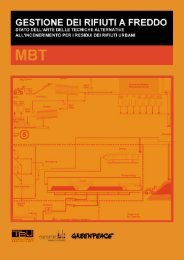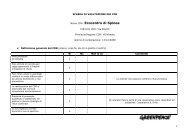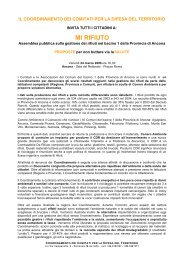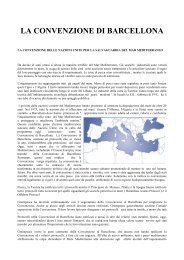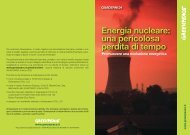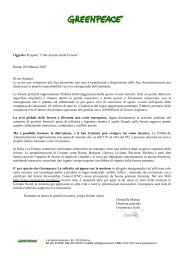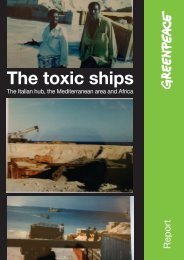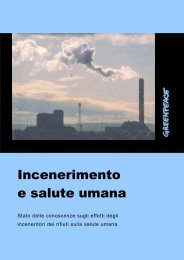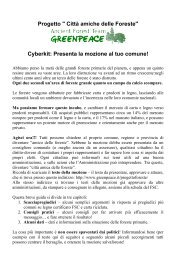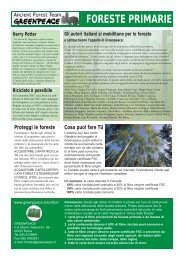Zero Waste by Robin Murray, Greenpeace Environmental Trust 2002
Zero Waste by Robin Murray, Greenpeace Environmental Trust 2002
Zero Waste by Robin Murray, Greenpeace Environmental Trust 2002
You also want an ePaper? Increase the reach of your titles
YUMPU automatically turns print PDFs into web optimized ePapers that Google loves.
phasing out the production of the substances in question.<br />
In the words of the Agreement, ‘They simply must not be<br />
available.’<br />
The three Agreements all relate to the pollution of water.<br />
The pollution can come about in the process of<br />
production, use or disposal. It can pass directly to water<br />
(through water emissions in production for example) or<br />
indirectly via the air, or through run-offs and leaching to<br />
water from land. Solid wastes are one form that can<br />
transfer or increase the pollution.<br />
Z e ro <strong>Waste</strong> as applied to solid waste carries with it the idea<br />
of reducing with the aim of eliminating the presence in<br />
wastes of substances ‘harmful to man or nature’. It means<br />
reducing all forms of toxic waste entering the waste stre a m ,<br />
and methods of treatment of waste materials which result in<br />
‘persistent toxic substances’ entering the environment.<br />
<strong>Zero</strong> <strong>Waste</strong> goes beyond the existing practices of<br />
separating out hazardous materials and subjecting them to<br />
more stringent disposal requirements, and of basing<br />
required levels of control (at hazardous and nonhazardous<br />
sites) on assimilative capacities and acceptable<br />
discharges. It does not stop with end-of-pipe controls.<br />
Such controls have faced repeated problems of regulatory<br />
infringement, of the switching of pollution from one<br />
means of discharge to another (as with incinerator air<br />
emission controls, where toxicity is switched from air to<br />
ash and to the water used for plant cleaning), and of the<br />
lack of controls on emissions whose long-term health<br />
effects are not yet known (such as micro-particulates).<br />
Rather the aim of <strong>Zero</strong> <strong>Waste</strong>, like zero discharge, is to<br />
track to the source the cause of toxicity and control it <strong>by</strong><br />
substituting non-toxic alternatives.<br />
As such, <strong>Zero</strong> <strong>Waste</strong> invokes the principle of Clean<br />
Production. Clean Production aims to phase out the<br />
generation and use of toxic chemicals and materials <strong>by</strong><br />
redesigning products and manufacturing methods to<br />
eliminate the inputs of toxic substances. 32 It targets toxic<br />
substances such as long-lived radioactive materials and<br />
heavy metals, which have been persistent sources of waste<br />
pollution. Its current priority is the phasing out of<br />
organohalogens, the substances specifically targeted in the<br />
OSPAR and Barcelona Agreements. Of the three principal<br />
organohalogens – organochlorines, organobromines and<br />
organoiodines – it is organochlorines that are the focus of<br />
immediate attention (the twelve priority pollutants of the<br />
current Stockholm Convention all being organochlorines).<br />
<strong>Waste</strong> products containing organochlorines (such as PVC,<br />
solvents, and PCBs) are the source of dioxins produced <strong>by</strong><br />
incineration, and of many of the toxic effects of landfills.<br />
(ii) zero atmospheric damage<br />
The second principle of <strong>Zero</strong> <strong>Waste</strong> is the reduction to<br />
zero of atmospheric damage resulting from waste. With<br />
respect to climate change the first issue is the reduction of<br />
methane emissions from landfills. This would largely be<br />
ended <strong>by</strong> prohibiting the landfilling of untreated biological<br />
waste. Article 6 of the EU’s Landfill Directive contains<br />
such a provision which should be interpreted – from the<br />
environmental rather than the bureaucratic perspective –<br />
as requiring forms of treatment of residual waste which<br />
reduce the fermentability of the organic fraction to no<br />
more than 10% of its initial level. <strong>Zero</strong> <strong>Waste</strong> here means<br />
zero untreated waste to landfill. 33<br />
A wider question is how the management of waste can<br />
help restore the carbon balance. <strong>Zero</strong> <strong>Waste</strong> in this<br />
context does not (and could not) mean eliminating CO2<br />
emissions but rather:<br />
• the minimisation of the loss of energy embodied in<br />
existing materials and products and of the use of fossil<br />
fuel energy for the process of recycling;<br />
• <strong>Zero</strong> <strong>Waste</strong> of carbon that could be sequestered<br />
through the return of composted organic materials to<br />
the soil.<br />
22<br />
<strong>Zero</strong> <strong>Waste</strong><br />
23



